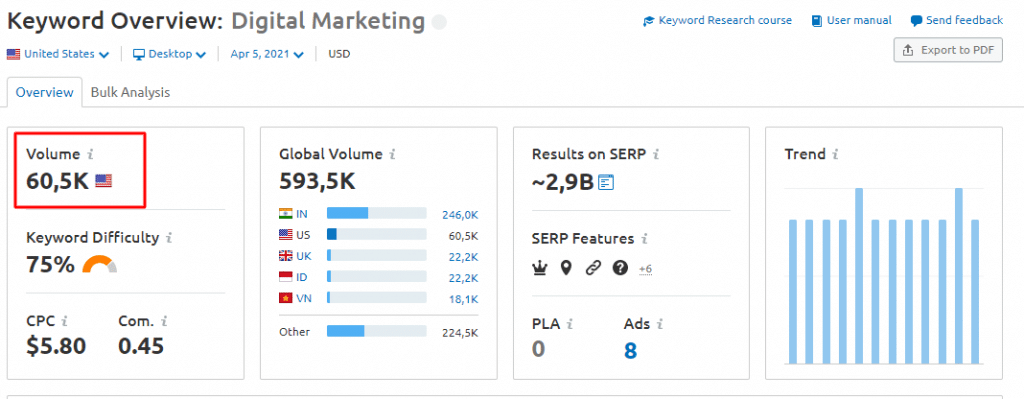As you may have previously noticed, Content Marketing is one of our pillars at Rock Content.
In addition to the 2,000-plus customers we’ve helped reach the top results on Google, our own content has made it there as well.
Our blogs serve as our showcase and testing lab for the latest trends, the boldest strategies, and innovative formats.
By using the best optimization practices, creating quality content, and (of course) patience, our Brazilian blog exceeded 3 million sessions in a month. For our Spanish-language blog, we’ve hit the milestone of 4 million monthly sessions.
And now, finally, it’s time to share the first success case of our English blog: in 11 months, we’ve increased our traffic by more than 15 times!
So if you want to learn step-by-step how to design your content strategy, plus get access to a free interactive checklist, read on!
The (Re)birth of Our Rock Content North America Blog
In 2019, Larissa Lacerda and I shared the editorship of Rock Content’s Brazil Blog. Our blog went through a massive migration at the beginning of the year, and we were beginning to reap the results of bringing our domain back home (rockcontent.com).
Our strategy was extremely well-consolidated: the project’s freelancers knew our content production guide by heart, we were publishing around 90 pieces of content a month, we addressed the most diverse clusters in the digital world, our DA was high and stable, and we had market recognition.
By the end of that year, Rock Content had made two acquisitions, increasing the suite of products we offered to our customers.
One of these acquisitions was from Scribblelive, an American company with operations based in the United States and Canada, which offered platforms to produce interactive content and live experiences.
Transforming Scribblelive into Rock Content
At the beginning of 2020, we launched a project to apply the same Content Marketing strategies that we had used on our Portuguese and Spanish-language blogs to our English blog.
We decided to use Scribble’s former domain, even though their blog didn’t have our volume of publications or content so focused on SEO.
We would have to start from scratch, undergoing the same process as our sister blogs. So this was the (re)birth of the Rock Content North America Blog — or as I kindly refer to it, our NA Blog.
I took over as chief editor of the blog, faced with the challenge of turning it into a lead generator in the USA and Canada.
Back in our first month, April 2020, we were seeing monthly traffic of just over 5,000 sessions.

And now, in March of 2021, we’re closing the month with over 79 thousand sessions.

This growth was entirely organic, increasing our brand recognition in the American market and conquering Google’s top results.

It has been a challenging journey, but full of lessons.
I’ll lay out the main points we focused on here, for you to understand where to begin your strategy. And if your company is going through an internationalization process, this content will be even more valuable!
The 6 most effective strategies to grow your blog
No clickbait, I promise.
I’ve listed the main strategies we used below, along with a brief explanation of how you can also put them into practice.
Localization and translation are different
This initial point is crucial for internationalization strategies.
So, repeat with me: you need to localize your strategy, not just translate it.
American companies are ahead with Digital Marketing. This is not dog talk.
Hubspot created Inbound Marketing. This is my key piece of evidence to prove my previous statement.
In Brazil, Rock Content is fighting for the same “Inbound Marketing” SERP against other companies that learned about this technique from Hubspot.
But on Rock’s NA Blog, I’m competing for the SERP with the company that created the technique. Do you see the difference?
So how does this impact our strategy in practice?
The first point is that our buyer personas are different in each case. There’s no point just translating your Brazilian buyer persona and offering it to a different market — it almost certainly won’t be well-suited.
Our Brazilian buyer persona, at an intermediate level of knowledge, might correspond to an American buyer persona at a basic level.
The same holds true for your content. The intent that lies behind a user’s search in Brazil may be completely different from search intent in Canada.
While translating existing content is easier than starting from scratch, it won’t necessarily guarantee the results you’re expecting.
Whenever I find interesting content on our blog in Portuguese or Spanish, I search for the same keyword on Google and open all of the results from the first page.
Then, if the intertitles match up, I’ll follow up with the localization process. If they’re out of sync, I’ll produce a new text.
The localization process
To be precise, the localization process is locating your content within a new country.
It’s a task far more focused on cultural aspects than simply translating the language. You need to consider which references and examples will resonate with your new audience.
Expressions and slang need to be taken into consideration. Brazilian expressions won’t necessarily work for your Mexican audience. Or American. And on and on.
Never use automatic translation tools. Although these tools have advanced a lot in recent years, they still won’t faithfully match natural speech patterns.
Finally, try to work with editors and proofreaders who are native users of the target language you’re working towards.
Even though many Brazilian writers have advanced English and produce grammatically correct texts, a native speaker brings a different perspective. Expressions that come off as too formal or aren’t used in practice, can create a sense that something’s off.
This was one of the most valuable lessons I learned.
Link building is vital to your SEO strategy
User experience is a key factor for your strategy. Crucial points here include page load time and how responsive your layout is, plus high-quality content, of course.
But it’s precisely because these elements are so essential that I won’t focus on them too much right now.
There’s no point in following the rest of these suggestions if, at the end of the day, your content doesn’t offer value to users. This includes content that doesn’t meet its objective because it’s not well written or is superficial information.
What we’re going to dissect here is the importance of link building.
This strategy, frequently ignored, may be the missing piece to improve your ranking.
Work with clusters
We work with a cluster structure on our blogs. This means that we have a pillar post, usually a guide to a subject, then several satellite posts.
When I took on our English-language blog, I built a spreadsheet with the most important keywords that we would start addressing. These were my clusters.
Let’s take a look at an example here, our Digital Marketing cluster, featuring a pillar post that’s a complete guide on the subject.
I used the skyscraper technique to build it, meaning I searched for what competitors were talking about and produced an even better text, covering several key points.
As you can imagine, the keyword “Digital Marketing” has a very high search volume. More precisely, we’re talking over 60 thousand searches per month.

Ranking for this term on Google’s USA SERP would be very difficult. I’d be competing against brands and organizations like Hubspot, Wikipedia, Marketo, Digital Marketing Institute, and more.
So, I focused on working on this as a cluster. For a couple of months, I prioritized a large volume of my posts on Digital Marketing satellite content, seeking a balance between head and long-tail keywords.
Long-tail gave me more opportunities to rank faster, since the search volume was lower.
I couldn’t focus solely on long-tail keywords, however, as I wouldn’t achieve the traffic I was looking for.
So I took advantage of SEMrush, using its “Keyword Magictool” field, to search for long-tail keywords related to Digital Marketing. These included:
- Digital Marketing Tools
- Digital Marketing Channels
- Digital Marketing Trends
- Digital Marketing Examples
- Digital Marketing Funnel
Notice how all of these texts link to my Digital Marketing pillar post in their first paragraph. Moreover, I also looked for opportunities to link to the satellites from within my pillar post.
It’s this synergy of links that helps Google’s bots find my pages faster, index them, and increase their chance of ranking.
When you publish a text but don’t link it to other content, it becomes an orphan page. This directly impacts how it ranks.
In the worst-case scenario, Google won’t even know it exists and won’t index it. In a slightly better scenario, Google will merely assume that it’s not important and will prioritize competitors.
Apply the 5-link rule
This is a rule that we use on Rock’s Brazilian blog that has yielded good results. Every time I post new content, I dive back into the blog and look for at least 5 other blog posts that can link to it.
Whenever it makes sense, prioritize your cluster pillar posts.
Note that this needs to be natural. Never force a link, because it will frustrate your reader. Above all, offer your users the best possible experience.
This will help index your content faster.
Increase brand awareness with guest posts and co-marketing
When organic, guest posts and co-marketing partnerships can massively impact your blog.
Regarding internationalization, they can be even more useful for increasing brand awareness in new countries.
For guest posts, search for blogs that correlate with yours, then offer unpublished content that aggregates to the domain audience.
In the case of co-marketing, also look for partners that resonate with your buyer persona. Based on who you find, develop content formats that can be produced together.
Whether an ebook, a tool, a webinar, look for what’s relevant to the audience of both companies.
After all, this is exactly the focus of this kind of partnership: introducing new audiences to your brand.
But as I mentioned above, this strategy needs to be organic. At some point in your career, you’ll be offered money to add a link. Never accept this proposal.
Google can tell when a domain is making these deals and it penalizes the offending domain, as well as those related to it. Heed the sage advice, “Tell me who you walk with, and I’ll tell you who you are.”
When it comes to partnerships, make sure you’re choosing wisely, avoiding black hat strategies.
To ease your concerns, know that there are tools that assist with evaluating the health of potential partners. Below is the list of key points I always check before signing off on a guest post or co-marketing opportunity.
Analyze partner domains
The first step is to evaluate the website and blog. I read the information, understand what their company does, then analyze if there’s a fit between our service and theirs.
If we are competitors in any product, I reconsider the partnership. If our buyer personas completely differ, I also refuse.
It’s important to note whether the area of expertise makes sense too. I once received a partnership proposal for a social media management platform.
The other party identified strongly Rock, but their focus was offline marketing and trade marketing issues.
They let me know that I couldn’t talk about digital — so what would be the point of producing a guest post for them?
Today, we’re experts in Digital Marketing and Content Experiences. What would be the strategy behind creating content about organizing supermarket shelves?
Check blog post frequency
Content Marketing requires consistency. If you only post content every month, it’s unlikely that you’ll achieve the results you’re looking for.
So I only partner with companies that have an active Content Marketing strategy. Their blog needs to be consistently updated with quality content.
If not, it’s not worth the effort on our part.
Check domain authority (DA) and spam
This is the most important step in this analysis. It’s where you understand if the partner’s domain is content you want to be associated with.
I use Moz’s free tool and recommend you do the same. Simply install a Chrome extension, then whenever you want to know the DA of a page, just click on the Moz icon.
With this tool, you can easily discover the DA or spam rating of a page. While many question what good domain authority is, it varies greatly across niche markets.

When running this analysis, compare yourself with your competitors. If the majority are in their 45s and the guest post partner is too, feel free to go ahead. However, if their DA is 20, you should reconsider.
On the other hand, spam indicates that a domain is making inappropriate links. For example, a person who leaves several links to their blog in the comments on a random blog post. This is considered link spam, the last practice you want to have your domain linked to.
I would not accept partnerships with domains that rate as more than 4% spam.
By following these tips, you can ensure that you’re only connecting your blog with other healthy blogs.
These indicators reveal how likely a site is to follow Google’s guidelines and offer a good experience to its audience.
Promote your content on the right channels
Promoting a new blog is just like having a party at your home.
You get the food and drinks, you set up the decorations, you hit play on the playlist — but you didn’t tell anyone what day the party is or where you live. Yet you expect people to show up somehow, as if by magic.
You could have a blog with the most in-depth educational content, the most beautiful layout, but if people don’t know where you are, they’ll take too long to find you.
This is because when you create your blog, your DA is low. After all, it takes time and a strategy in action to gain authority. Without this, it’s unlikely that you’ll rank well right away.
And this is where content promotion channels come in. For our NA Blog, we use social networks, some email marketing, and Pushnews.
So I recommend that you use a feed for your blog. By doing so, your new content will automatically be sent to your subscribers. Believe me, this can have a huge impact on your traffic. In addition to retaining your readers, they’ll constantly be reminded of visiting your page.
Another golden tip is to find web directories or small content curators. In such cases, the audience itself is suggesting articles that should be promoted there. The more people who click on a link, the more prominence it gets.
I realized that this type of curation is very common in the US and, thanks to these directories, we received an additional 2 thousand sessions.
Audit frequently
The best way to find errors is to look for them — hard.
I used SEMrush projects to constantly audit our blog.
Every month, I’d visit there to see what errors were cropping up, points of attention, and improvement opportunities.
You can find broken links, images without alt text, pages lacking meta descriptions, among other points that will improve your SEO.
You can also (and should!) run audits on Pagespeed Insight. By doing so, you’ll see improvements you can make through the page load speed.
After all, Google has already made it clear that this is one of their main ranking factors. So while you may not achieve a higher ranking by making your site faster, you’ll certainly lose places by slowing it down.
Be patient
This is perhaps the most precious, and most difficult, tip I can offer.
Content marketing is a long-term strategy.
As I said above, our NA Blog project started in April 2020. Some content pieces we posted at that time only ranked on Google’s first page of results in October 2020.
There are still several other pieces that I’m handling to reach the top results.
And this takes into consideration the fact that our DA was already high, due to our blog being under the Rock Content domain. In other words, a good part of the path had already been covered.
But for a lasting strategy, it’s necessary to be patient, complying with all of Google’s guidelines, and following honest principles.
I’m not going to lie, I’ve seen blogs rank faster through dishonest strategies. But once Google found out and penalized these pages, I no longer see these domains on the SERPs.
I can guarantee that it’s better to wait 6 months to reach the first place and stay there than to conquer it quickly but lose it at the same speed.
We’ve reached the end of our first successful case study for the Rock Content North America Blog!
I’m sure we still have a lot more stories to tell and knowledge to share.
Starting a Content Marketing strategy from scratch, especially in such a competitive market, taught me to follow to the letter everything I learned about marketing over the years.
My main metric continues to be building for quality and a trusting relationship with our reader base.
To help you on this journey, we’ve created an interactive checklist with the main techniques that we’ve used over the past year. If you want to leverage your results, be sure to check it here for free!








